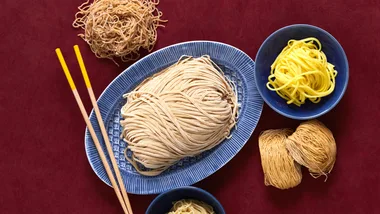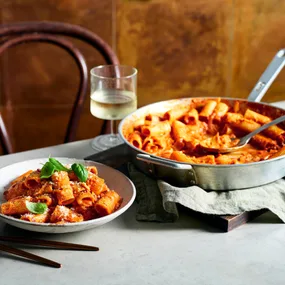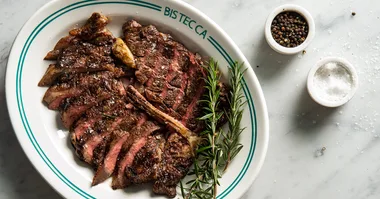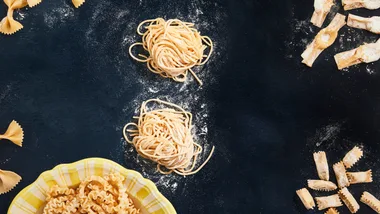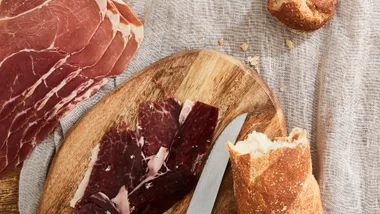Learn how to make one of the most iconic Italian dessert – cannoli. Gourmet Traveller’s cannoli guide will give you perfect, crispy pastry and creamy ricotta cheese filling every time.
Step into any pasticceria worth its salt – or should that be sugar? – and pride of place is likely to be taken by a pile of crisp-shelled cannoli bursting with a creamy ricotta filling and snowy with a dusting of icing sugar. They’re arguably Italy’s most recognised pastry, and once you bite into one, it’s easy to understand why: these Sicilian delicacies are difficult to beat.
What is cannoli?
Cannoli are Italian pastries made from crispy, fried pastry dough that moulded into a tube-like shape and filled with a sweet, creamy ricotta filling.
Where does cannoli come from?
It’s thought cannoli originated in western Sicily, around the Palermo region. The pastries were considered a springtime delicacy, as they were served as a treat during the Carnevale celebrations that took place before Lent. The original filling is believed to have been a combination of wine, rosewater and ricotta; traditionally it was made with sheep’s milk ricotta, which, with Sicily’s lush green spring pastures, was plentiful at that time of year.
How to make cannoli
Making your own cannoli may seem like a difficult task, but if you have a pasta machine and are willing to put in a little elbow grease, it’s easier than you might think. And the dividend is well worth the effort: a freshly filled cannolo, with its shell still crisp, is a very different thing from most shop-bought versions, which often have been filled several hours earlier and are on the soft side as a result.
Cannoli dough is simple to make. Flour, sugar, eggs and butter are given a burst of flavour with the addition of vin santo and ground cinnamon, while the merest smidge of cocoa gives the finished cannoli a beautifully dusky tone. We found that kneading the dough by hand, rather than in a mixer, limited the risk of over-working the dough and gave the best result. As with any dough-making, resting time (for the dough, not the cook) is important, as it allows the strands of gluten in the dough to relax. Then it’s just a case of rolling and folding, rolling and folding through your pasta machine until the dough is 2mm thick.

Step 3.
Cannolo – the singular form – is derived from the term canna, which means a cane-like reed such as sugar cane. In earlier centuries, this is what the cannoli pastry was moulded around. These days, cannoli can be moulded around purpose-made metal tubes, available from specialist kitchenware shops. Unless, however, you’re a truly dedicated cannoli pasticciere, it’s more practical to use dried cannelloni pasta tubes, as we have here. There are cannoli as thin as a cigarette (aptly called sigaretta) and as big as a fist, but we found the dried cannelloni produced an ideal size that are easy to handle and, more importantly, just the right size to warrant seconds.

Step 5.
When wrapping and sealing the pastry around the cannelloni it’s important to ensure no eggwhite gets onto the pasta tube; if it does, it makes it very difficult to remove the cannoli shell from the tube once it’s cooked and ready for filling. You can re-use the cannelloni tubes if you like, cooking one batch and sliding the cannoli from the tubes before assembling more; just make sure you keep an eye on the cannoli as they cook, and be sure to turn them frequently so they cook evenly.
How to make cannoli filling
Traditionally, cannoli filling is made from Sheep’s milk ricotta, however, the cannoli we devour today are made from ricotta cheese.
Although a crisp and crunchy shell is imperative for achieving a quality cannolo, the perfect filling is also crucial. Sheep’s milk ricotta is traditional, but it’s not readily available, and today in pasticcerie and Italian delicatessens you’ll find many cannoli made with cow’s milk ricotta. That said, using the best-quality ricotta you can find will significantly influence the result. Buy ultra-fresh firm ricotta from a delicatessen or a deli counter with a high turnover, and if it looks a little watery, drain it overnight in the fridge in a muslin-lined sieve placed over a bowl.
The ultimate key to cannoli success is to fill the cannoli shells only moments before they’re served.
Ingredients
Method
Main
Note Cedro is the glacé fruit of the citron tree. It’s available from good delicatessens; if it’s unavailable, substitute candied lemon peel.
Notes


